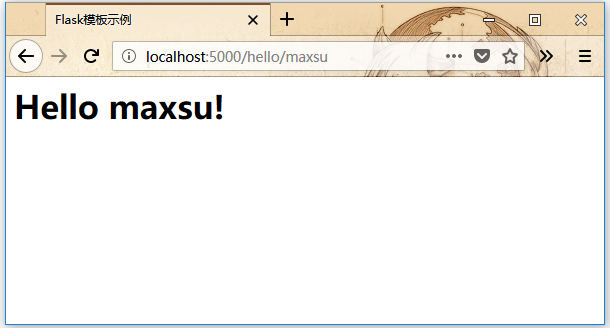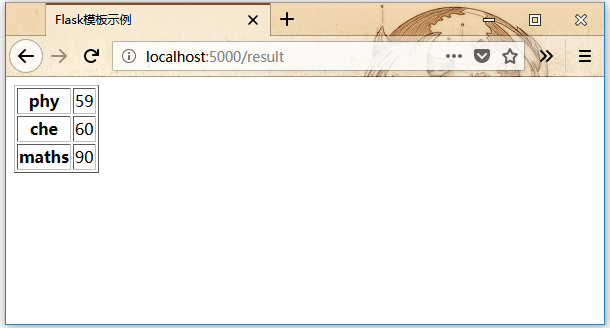Flask 教程
Flask 模板
Flask可以以HTML形式返回绑定到某个URL的函数的输出。 例如,在以下脚本中,hello()函数将使用附加的<h1>标记呈现 ‘Hello World’ 。
# Filename : example.py
# Copyright : 2020 By Nhooo
# Author by : www.cainiaojc.com
# Date : 2020-08-08
from flask import Flask
app = Flask(__name__)
@app.route('/')
def index():
return '<html><body><h1>'Hello World'</h1></body></html>'
if __name__ == '__main__':
app.run(debug = True)但是,从Python代码生成HTML内容非常麻烦,尤其是在需要放置可变数据和Python语言元素(如条件或循环)时。经常需要转义HTML代码。
它可以利用Jinja2模板引擎技术,而不需要从函数返回硬编码HTML。如下代码所示,可以通过render_template()函数渲染HTML文件。
# Filename : example.py
# Copyright : 2020 By Nhooo
# Author by : www.cainiaojc.com
# Date : 2020-08-08
from flask import Flask
app = Flask(__name__)
@app.route('/')
def index():
return render_template(‘hello.html’)
if __name__ == '__main__':
app.run(debug = True)Flask将尝试在该脚本所在的同一文件夹中查找templates文件夹中的HTML文件。使用模板的应用程序目录结构如下所示 -
# Filename : example.py # Copyright : 2020 By Nhooo # Author by : www.cainiaojc.com # Date : 2020-08-08 app.py hello.py templates hello.html register.html ....
术语“Web模板系统”是指设计一个HTML脚本,其中可以动态插入变量数据。 Web模板系统由模板引擎,某种数据源和模板处理器组成。
Flask使用jinga2模板引擎。 Web模板包含用于变量和表达式(这些情况下为Python表达式)的HTML语法散布占位符,这些变量和表达式在模板呈现时被替换为值。
以下代码在模板( templates)文件夹中保存为: hello.html。
# Filename : example.py
# Copyright : 2020 By Nhooo
# Author by : www.cainiaojc.com
# Date : 2020-08-08
<html>
<head>
<meta http-equiv="Content-Type" content="text/html; charset=utf-8" />
<title>Flask HTTP请求方法处理</title>
</head>
<body>
<h1>Hello {{ name }}!</h1>
</body>
</html>接下来,将以下代码保存在 app.py文件中,并从Python shell运行 -
# Filename : example.py
# Copyright : 2020 By Nhooo
# Author by : www.cainiaojc.com
# Date : 2020-08-08
from flask import Flask, render_template
app = Flask(__name__)
@app.route('/hello/<user>')
def hello_name(user):
return render_template('hello.html', name = user)
if __name__ == '__main__':
app.run(debug = True)在开发服务器开始运行时,打开浏览器并输入URL为 - http://localhost:5000/hello/maxsu
URL的可变部分插入{{name}}占位符处。

Jinja2模板引擎使用以下分隔符来从HTML转义。
{% ... %} 用于多行语句 {{ ... }} 用于将表达式打印输出到模板 {# ... #} 用于未包含在模板输出中的注释 # ... ## 用于单行语句
在以下示例中,演示了在模板中使用条件语句。 hello()函数的URL规则接受整数参数。 它传递给hello.html模板。 在它里面,收到的数字(标记)的值被比较(大于或小于50),因此在HTML执行了有条件渲染输出。
Python脚本如下 -
# Filename : example.py
# Copyright : 2020 By Nhooo
# Author by : www.cainiaojc.com
# Date : 2020-08-08
from flask import Flask, render_template
app = Flask(__name__)
@app.route('/hello/<int:score>')
def hello_name(score):
return render_template('hello.html', marks = score)
if __name__ == '__main__':
app.run(debug = True)模板文件: hello.html 的HTML模板脚本如下 -
# Filename : example.py
# Copyright : 2020 By Nhooo
# Author by : www.cainiaojc.com
# Date : 2020-08-08
<html>
<head>
<meta http-equiv="Content-Type" content="text/html; charset=utf-8" />
<title>Flask模板示例</title>
</head>
<body>
{% if marks>50 %}
<h1> 通过考试!</h1>
{% else %}
<h1>未通过考试!</h1>
{% endif %}
</body>
</html>请注意,条件语句if-else和endif包含在分隔符{%..。%}中。
运行Python脚本并访问URL=> http://localhost/hello/60 ,然后访问 http://localhost/hello/59,以有条件地查看HTML输出。
Python循环结构也可以在模板内部使用。 在以下脚本中,当在浏览器中打开URL => http:// localhost:5000/result时,result()函数将字典对象发送到模板文件: results.html 。
result.html 的模板部分采用for循环将字典对象result{}的键和值对呈现为HTML表格的单元格。
从Python shell运行以下代码。
# Filename : example.py
# Copyright : 2020 By Nhooo
# Author by : www.cainiaojc.com
# Date : 2020-08-08
from flask import Flask, render_template
app = Flask(__name__)
@app.route('/result')
def result():
dict = {'phy':59,'che':60,'maths':90}
return render_template('result.html', result = dict)
if __name__ == '__main__':
app.run(debug = True)将以下HTML脚本保存为模板文件夹( templates)中的模板文件: result.html 。
# Filename : example.py
# Copyright : 2020 By Nhooo
# Author by : www.cainiaojc.com
# Date : 2020-08-08
<html>
<head>
<meta http-equiv="Content-Type" content="text/html; charset=utf-8" />
<title>Flask模板示例</title>
</head>
<body>
<table border = 1>
{% for key, value in result.items() %}
<tr>
<th> {{ key }} </th>
<td> {{ value }} </td>
</tr>
{% endfor %}
</table>
</body>
</html>在这里,与For循环相对应的Python语句包含在{%...%}中,而表达式键和值放在{{}}中。
开发开始运行后,在浏览器中打开http://localhost:5000/result以获得以下输出。
